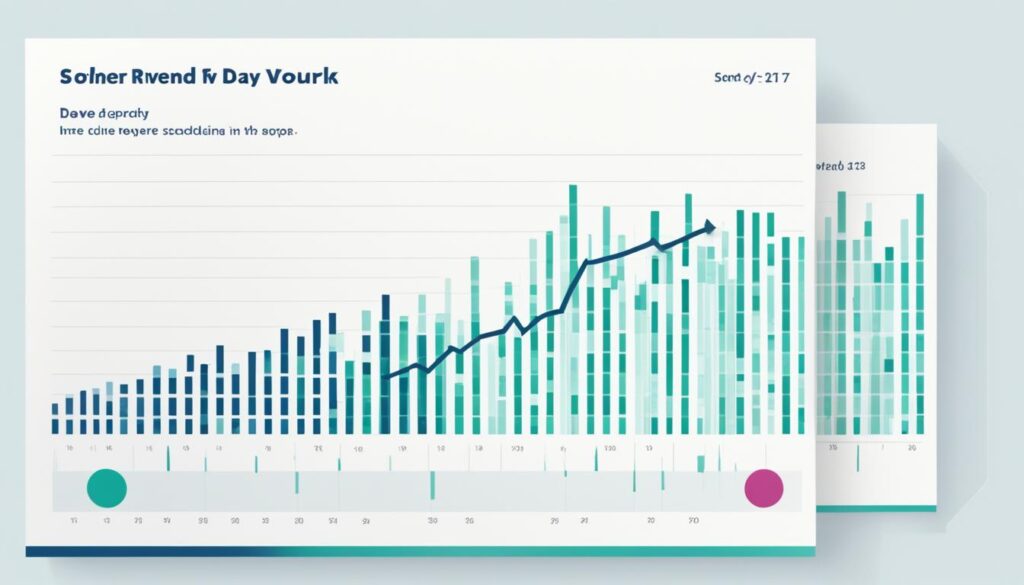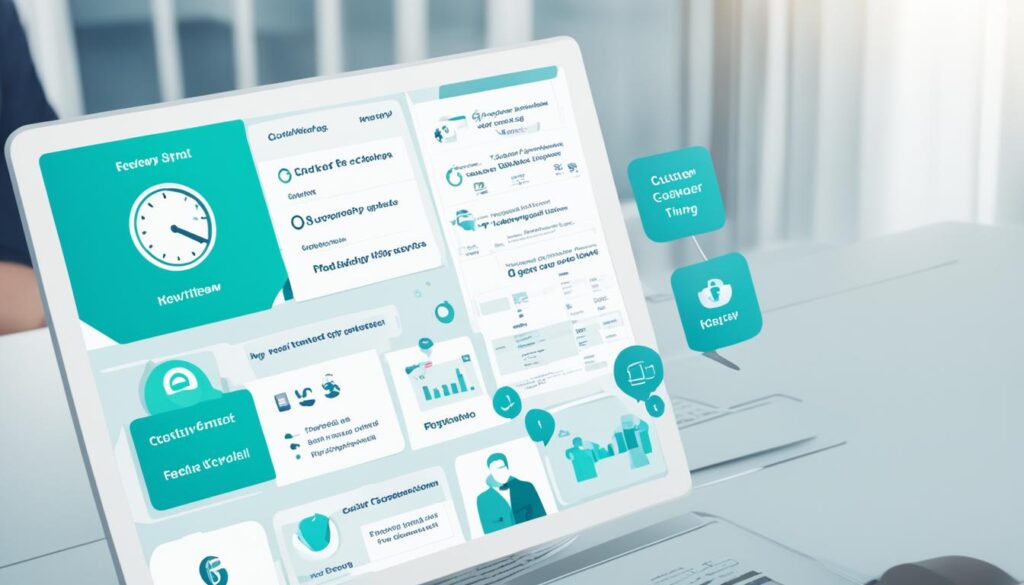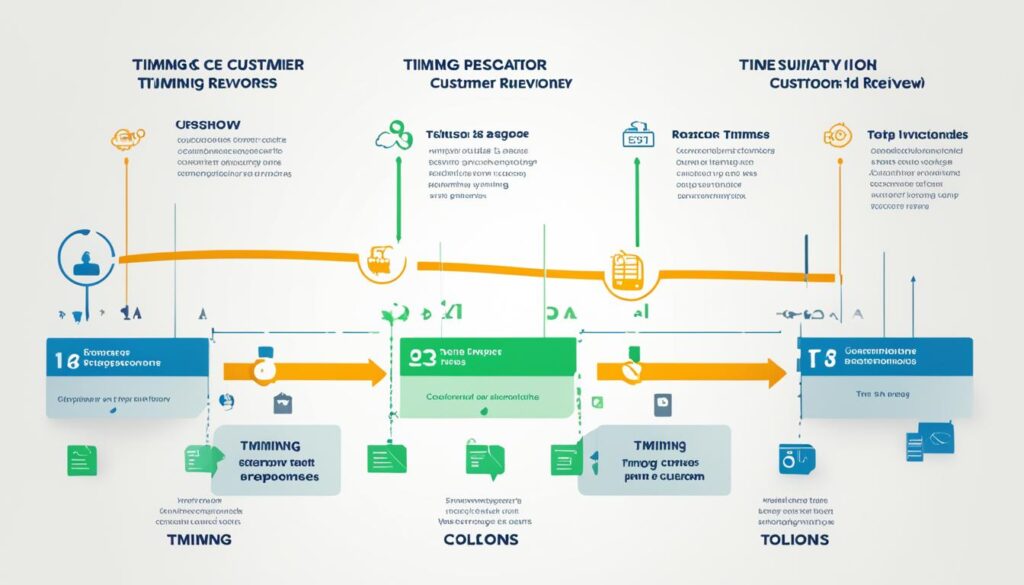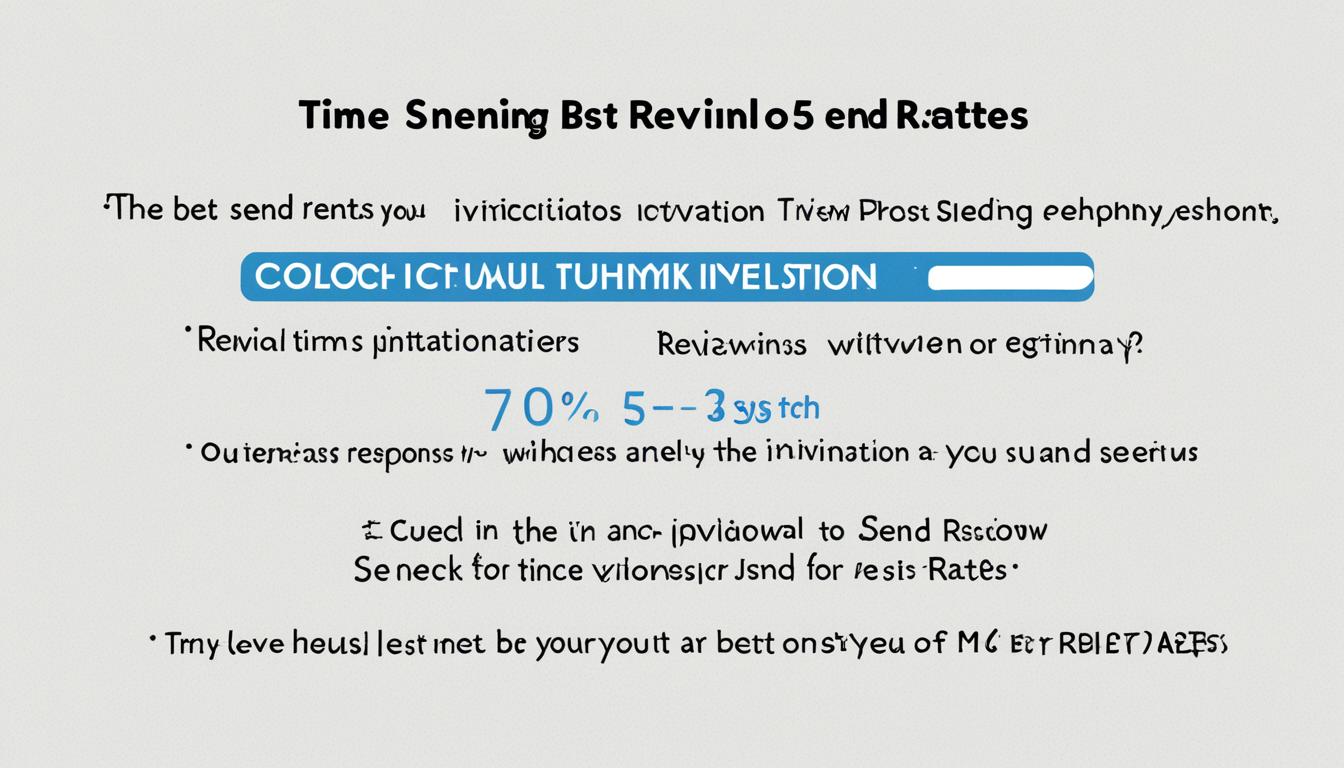Ever wondered why some review invites get ignored while others get a quick response? It’s all about timing. In peer reviews and customer feedback, when you ask is as important as what you ask. Let’s explore the best ways to time your review invites to get more responses.
Timing is key for review invites. A well-placed request can lead to a lot of responses or just a few. Did you know sending a pre-invitation can really help get more people to respond? This works even better with a cash reward1. But it’s not just about the first invite. Following up with a reminder a week later can also help increase responses1.
Today, online reviews are very important. Most customers read them, and 80% trust them as much as advice from friends or family2. This shows how crucial it is to collect reviews well. The process isn’t just about getting many reviews; it’s also about their quality and timing. Many consumers think a review should be written within a month to be useful2.
Small changes in how you invite people can make a big difference. For example, using a real name in your email invites can increase responses by 50%. And putting the first survey question right in the invite can boost responses even more, by over 50%3. These tips show that paying attention to the details can really help get more reviews.
Key Takeaways
- Prenotifications and reminders can significantly increase response rates
- The majority of customers rely heavily on online reviews
- Reviews should be collected within a month to maintain relevance
- Using a real person’s name in email invitations boosts response rates
- Embedding the first survey question in the invite can dramatically improve responses
Understanding the Importance of Timing in Review Invitations
The peer review process is key in the research journey, from start to finish. Getting the timing right for review invitations can greatly change how many people respond and how they act4.
When we send out invitations, it matters when we do it. Even though more emails go out on weekdays, it doesn’t always mean more people open them. Tuesday is the best day for getting people to open emails, and Friday is the best for getting them to click on links. Surprisingly, emails sent on Saturday often get opened more than others.
It’s important to think about how much work reviewers have on their plates. If reviewers are too busy, they might not be able to give good reviews or might even pull out. Setting deadlines that are realistic helps keep reviewers happy and ensures they give thorough reviews4.
Usually, we aim for two outside reviewers for each paper, but some research needs more. A good plan is to have a list of at least six possible reviewers and invite three to four at first5.
Using tools that make inviting reviewers easier can cut down on time wasted. Things like saving lists of potential reviewers, sending invites to several people at once, and automatically inviting the next person on the list make things run smoother5.
By knowing these things and doing things the best way, we can get more people to respond and make sure the reviews are top-notch in academic publishing.
Choosing the Right Day of the Week for Review Invitations
Finding the best day to send review invitations can really boost how many people open and click on your emails. We’ve looked into the data to help you pick the best day between weekdays and weekends.

Mondays are the top choice for getting responses from both customers and team members. Customer surveys get 10% more replies on Mondays, and team surveys see a 13% boost6. This shows how crucial timing is for getting people involved.
But, Fridays are the worst day for customer surveys, with a 13% drop in replies6. The difference between Monday and Friday is huge, with a very small chance of happening by chance, or p-value of 0.016.
| Day | Customer Survey Response Rate | Internal Survey Response Rate |
|---|---|---|
| Monday | +10% above average | +13% above average |
| Friday | -13% below average | Data not available |
Sending invites for big events like weddings 2 to 4 months early works best7. This gives guests enough time to plan and makes them more likely to say yes.
For email invites, having a catchy subject line is key to getting more opens7. The day you send it out can really affect how well your invite does.
Optimal Times of Day for Sending Review Requests
Knowing when to send emails is key to getting more opens and clicks. We looked into the best times for sending review requests. This focuses on optimizing when you send them.
In the early morning, lots of emails go out, but people don’t open them much. But, as the day goes on, people start to pay more attention. The best times for getting opens are just before 4 p.m., and it’s also good between 2 p.m. and 8 p.m.
| Time of Day | Open Rates | Click Rates |
|---|---|---|
| 8 AM – 12 PM | Low | Low |
| 2 PM – 4 PM | High | Moderate |
| 6 PM – 8 PM | High | Peak |
| 10 PM – 12 AM | Moderate | Peak |
Click rates are highest around 6 p.m., 10 p.m., and midnight. This could be because there’s less email in people’s inboxes, making your request more noticeable.

To get more responses, send your review requests 1-3 days after a good interaction or a successful buy8. This way, you’re not too soon, but not too late either. It keeps your product or service fresh in their minds.
Personal touches matter a lot. Using names and details about their experience can really help you get more positive reviews8. By sending emails at the best times and making them personal, you’ll get more people to respond.
Leveraging Email Subject Lines and Sender Information
Email subject lines are key to getting reviews. About 65% of marketers think they’re the most important part of email marketing9. It’s crucial to make them catchy, as 33% of people will open an email just because of it10.
For better open rates, keep subject lines short, between 30-50 characters. This helps them show up well on phones, since nearly half of customers check emails on their phones11. Try using phrases like “limited time offer” or “special discount awaits” to make people act fast.
Who sends the email matters a lot too. A big 45% of people will read an email if they know the sender10. Use professional email addresses to look credible and avoid getting marked as spam.
“The right subject line can make or break your review invitation campaign.”
Make your subject lines personal. Emails with the recipient’s name get opened 39% more often than those without10. Add these seven things to your review request subject lines:
- Personalization
- Brevity
- Motivation
- Timeliness
- Politeness
- Brand voice alignment
- Spam-free language
Remember, 95% of customers check reviews before buying online. By making your email subject lines and sender info better, you can get more valuable feedback11.
Timing of Review Invitations: Best Practices for Different Industries
Timing is key when sending out review invitations. B2B and B2C companies have different needs. Let’s look at some top tips for various industries.

For B2B companies, sending invites in the morning can increase responses by 5%. Mid-week invites can even boost it by up to 10%12. This matches what event planners know, with Tuesdays being the top choice for sending emails13.
In B2C industries, think about who you’re reaching out to. Retail businesses might do well on weekends when people are free. Restaurants could ask for reviews right after a meal, any day.
| Industry | Best Time to Send | Considerations |
|---|---|---|
| B2B Services | 9 AM – 1 PM, Tuesday-Thursday | Professional work hours |
| Retail | Weekends, 2-3 PM | Shopping patterns |
| Restaurants | 1-2 hours post-visit | Fresh experience |
| E-commerce | 2-3 days after delivery | Product usage time |
To get better results, send reminders to those who don’t respond. Do this twice a day, a few days apart. This can increase your response rate by up to 60%12. Always test and check your email open rates and RSVPs to find the best time for your industry and audience13.
Personalizing Review Invitation Timing Based on Customer Behavior
We’ve found that making review invitations personal can really boost how many people respond. By looking closely at how customers act, we can find the best time to ask for reviews. This method has brought in 40% more money for companies14.

Our study shows us how customers act and what they like. We send out review requests when they are most likely to answer. For example, hotels get more responses when they ask right after guests leave15.
It’s important to know what devices customers use. We send invitations at the best times for mobile or desktop users. This makes customers come back, with one in four saying it’s why they buy again14.
| Personalization Tactic | Impact |
|---|---|
| Cart abandonment messages | 45% increase in email revenue |
| Low-in-stock emails | Increased urgency in purchases |
| Back-in-stock notifications | Boosted sales opportunities |
Our data shows that making subject lines personal gets a 36% open rate, compared to 17% for generic ones14. We’ve also seen big wins with emails triggered by what customers look at online, making $200,000 to $250,000 a month16.
“Personalization is not just about timing; it’s about creating a connection that resonates with each customer’s unique journey.”
By using these personalized timing methods, we’ve cut customer acquisition costs by up to 50% and made customers happier, with 64% of marketers saying so14. Clearly, knowing and responding to what each customer does is key to great review invitations.
Utilizing Automation and Analytics for Optimal Timing
Smart businesses use automation tools and analytics to get their review invitation timing right. These tools make processes smoother, increase efficiency, and give deep insights into how customers act.
Automation tools make asking for reviews easier. They let businesses schedule and send invites at the best times. By automating alerts for new reviews, companies can quickly respond and get more people involved17. This quick action, usually within two hours or a day, helps manage negative feedback and grow support17.
Data-driven timing uses analytics to make smart choices. By looking at past campaign data, businesses spot patterns and trends in how customers react. This info helps plan when to send invites, making sure they reach customers when they’re most likely to take action.
A/B testing is a key way to fine-tune review invitation timing. By testing different send times, businesses can see what works best. This ongoing improvement based on results keeps companies ahead of what customers want.
Automation does more than just make things faster. It also makes the customer experience better. It lowers stress and workload for teams, leading to better service quality17. With 90% of people checking out reviews before visiting a store, automating reviews can greatly boost a business’s online image18.
By using automation tools, analytics, data-driven timing, and A/B testing, businesses can craft a strong plan for getting more reviews. This method not only saves time and money but also builds a stronger online reputation in today’s competitive world.
Conclusion: Maximizing Response Rates Through Strategic Timing
We’ve looked into how timing is key for sending out review invitations. By adjusting when we send them, we can greatly increase the number of responses. Research shows response rates vary widely, from 3% to 96.8%, showing the need for better strategies19.
Choosing the right time is vital for getting more replies. For B2B brands, aiming for a 40% response rate is good, with top brands aiming for 60%20. Sending reminders at the right time can boost responses by up to 50%20. Also, keeping surveys short and using simple subject lines helps keep people interested20.
In conclusion, getting the timing right for review invitations is crucial for getting more replies. By using automation, data, and personal touches based on what customers do, we can keep improving. A smart timing plan can lead to big wins – some companies get 80% new business from happy customers20. Let’s use these tips to make our review invitations better and get more people involved.
FAQ
Why is timing important when sending review invitations?
What is the best day of the week to send review invitations?
What is the optimal time of day to send review invitations?
How can I leverage email subject lines and sender information to improve response rates?
Are there industry-specific best practices for timing review invitations?
How can I personalize review invitation timing based on customer behavior?
How can automation and analytics help with timing optimization?
Source Links
- Optimizing the Invitation to Increase the Response Rate in Online Surveys – https://www.greenbook.org/insights/research-methodologies/optimizing-the-invitation-to-increase-the-response-rate-in-online-surveys
- Get a Better Response Rate on Customer Review Requests – https://www.getweave.com/how-to-get-a-better-response-rate-for-reviews-from-your-customers/
- How To Increase Survey Response Rates: The Complete Guide – https://www.genroe.com/blog/increase-survey-response-rate/11244
- All You Need to Know about the Peer Review Process – https://www.exordo.com/blog/reviewing-the-peer-review-process/
- External Reviewers for manuscripts: How many and when? Strategy? – https://www.manuscriptmanager.com/external-reviewers-invite-manuscript/
- When is the best time to send a survey? | SurveyMonkey – https://www.surveymonkey.com/curiosity/day-of-the-week/
- The Etiquette of Invitations: When and How to Send Them – Traveler’s Q – https://travelersq.com/the-etiquette-of-invitations-when-and-how-to-send-them/
- How to Ask for Reviews? Examples + Templates – https://embedsocial.com/blog/how-to-ask-for-google-reviews/
- How to write webinar email subject lines that drive higher open rates [+Examples] – https://www.linkedin.com/pulse/how-write-webinar-email-subject-lines-drive-higher-open-ntq2c
- The Best Webinar Email Subject Lines to Boost Registrations | Hubilo – https://www.hubilo.com/blog/webinar-email-subject-lines
- Top 15 Email Subject Lines For Review Requests | Sendlane – https://www.sendlane.com/blog/feedback-request-emails
- How to Ask Customers for Reviews – Reputation – https://reputation.com/resources/articles/when-is-the-best-time-to-ask-for-customer-reviews-2/
- Best Timing To Send Your Event Invitation Email – https://www.ticketspice.com/blog/best-timing-to-send-your-event-invitation-email
- The complete guide to customer personalization – https://www.growthloop.com/university/article/customer-personalization
- Personalized reviews: How to encourage and manage personalized reviews for your customers – FasterCapital – https://fastercapital.com/content/Personalized-reviews–How-to-encourage-and-manage-personalized-reviews-for-your-customers.html
- How to personalize your lifecycle marketing – https://cordial.com/resources/how-to-personalize-your-lifecycle-marketing/
- How To Automate Google Reviews: Boosting Your Reputation With AI – https://www.podium.com/article/how-to-automate-google-reviews-with-ai/
- 4 ways to automatically invite and track customer reviews | Zapier – https://zapier.com/blog/automate-customer-reviews/
- Optimizing Survey Response Rates in Graduate Medical Education Research Studies – https://journals.stfm.org/familymedicine/2023/may/ericson-2022-0344/
- 10 Ways to Improve NPS Response Rates [with benchmarks] – https://customergauge.com/blog/nps-survey-response-rate

